We spent 40+ hours working on this guide. It dives into materials, shapes, purposes and potential benefits of insoles and orthotics so you can make an informed decision: what do you actually need?
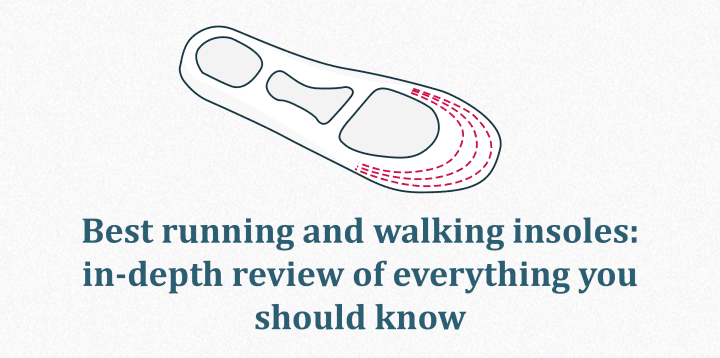
Many experts believe that people with minor issues or fatigue will do well with over-the-counter insoles. Orthotics are a better option for severe foot conditions.
1st disclaimer: if considering these inserts, make sure your running/walking shoes have removable insoles. If they are glued in, you won’t be able to switch them.
2nd disclaimer: The purpose of this guide is to educate, not make medical diagnosis. If you’re experiencing pain or going through an injury, a visit to the specialist is always recommended.
What are inserts and orthopedic insoles
Insoles (also known as inserts) are pieces of material put inside the shoes on which your feet rest. Their main purpose is to offer additional cushioning or support for your feet. In this context, they are bought over the counter.
Orthotics (also known as orthopedic insoles) are customized insoles made specifically for your feet. They are fabricated by medical specialists and usually used for treating specific foot conditions.
They both come in the place of the sock liner (a basic insole found in the shoe which, if nothing else, protects the feet from stitches and rough patches inside the shoe).
But before you embark on an insole-hunting journey, make sure you have the right shoes (check if they offer the support you might need, if they are firm enough for your feet, stable enough, wide enough, etc.).
What do you actually need?
While there are many brands out there making insoles (Superfeet, Sole, Dr. Scholl’s, Spenco, New Balance, Sidas, Currex, Powerstep, just to name a few), this guide focuses on the types of the insoles and their purpose based on their anatomy.
We’ve created a chart to guide you through. Everything noted in it is explained down the road in this guide. Keep in mind that this is a general overview and not a guarantee. Later on, you can read how successful insoles and orthotics are at treating certain conditions.
Prepare for take-off!

Insoles vs. orthotics: what’s the difference?
Here’s the overview of what sets inserts and orthotics apart.
| Insoles | Orthotics | |
| Also called | Inserts, footbeds, over-the-counter, prefabricated | Custom-made or customized foot orthotics, orthoses |
| Purpose | Cushioning and/or support | Cushioning and/or support but focused on the treatment of foot conditions |
| Customization | None to minimal (you can trim them to fit better in your shoes; some can be heated to mold to your feet better) | Maximal (made especially for your feet) |
| Duration of use | Short term to long term | Never short term |
| Where to buy | Over the counter | Certified medical practice (podiatrists, orthopedic surgeons) |
| Durability | Should be changed every 6-12 months | More durable than regular insoles |
| Price | $20-90 | $400-600 |
In terms of cushioning and support, here’s what that actually means for a runner. We will list the things that manufacturers of insoles and orthotics promote as benefits of their products. There are no guarantees.
Different types of shoe inserts
Cushioned inserts vs. supportive inserts
Putting orthopedic (fully customized) insoles aside, the “regular” ones come in 2 forms. Look at the overview below to understand what differentiates them.
- Cushioned insoles help with shock absorption and provide more comfort. However, keep in mind that the midsole of the shoe determines how the shoe feels and provides most of the shock absorption. Insoles can help improve that feeling, but only a bit.

- Supportive insoles offer arch support. If you’re new to this, read our in-depth guide on arch support. Anatomically they are different from the cushioned insoles because they have a dome built for arch support and deep heel cups. They optimally position your feet and encourage proper alignment. Cushioned insoles might have it as well. What makes the difference is how deep and stiff they are.
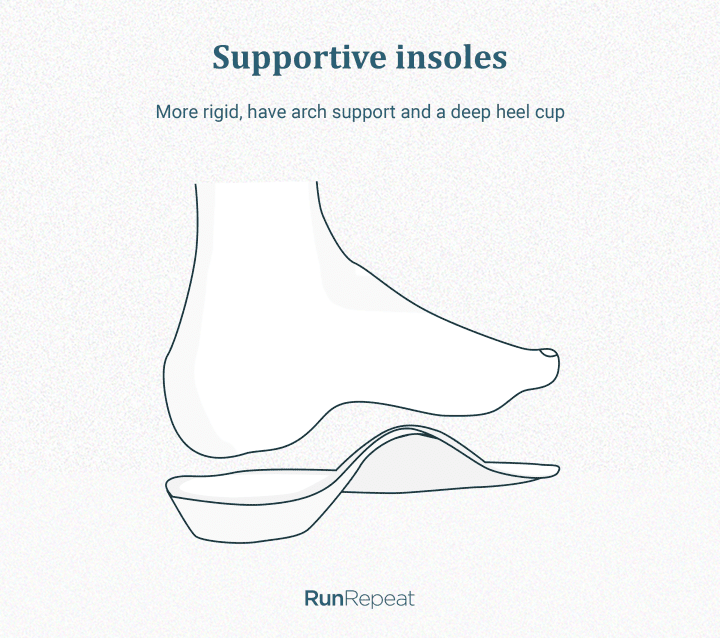
- There are combinations that act as the middle ground, called supportive cushions. They usually offer more cushioning than support.
| Cushioned insoles | Supportive insoles | |
| Also called | Accommodative | Functional |
| How they feel | Soft and flexible | Firm and they retain shape |
| Compared to basic sock liners | More comfortable | More rigid |
| Purpose | Cushioning, shock absorption, fatigue relief | Arch support, foot stabilization, strain relief, motion control |
| Anatomic comparison | No arch support | Stiffer heel hold, more rigid arch |
| Price | Cheaper | More expensive |
Partial shoe inserts
Next to full-length inserts, you can also find over-the-counter partial shoe inserts. Here, there are 4 categories:
- Heel cups (usually made out of gel or plastic and used for heel pain),
- Metatarsal pads (placed behind the ball of your feet, great for high heels and they reduce pain caused by metatarsalgia),
- Heel lifts (help to take the pressure off your calves or Achilles), and
- ⅔ length insoles (they don’t cover the area under your toes, usually used in dress shoes).

These inserts might come with adhesive bottoms to prevent sliding within the shoe.
Possible levels of customization in store-bought insoles
Full-length insoles should fit in perfectly. To ensure this, you should look for as many as possible factors that influence the fit. We will address each factor separately below. But, overall, the more the merrier:
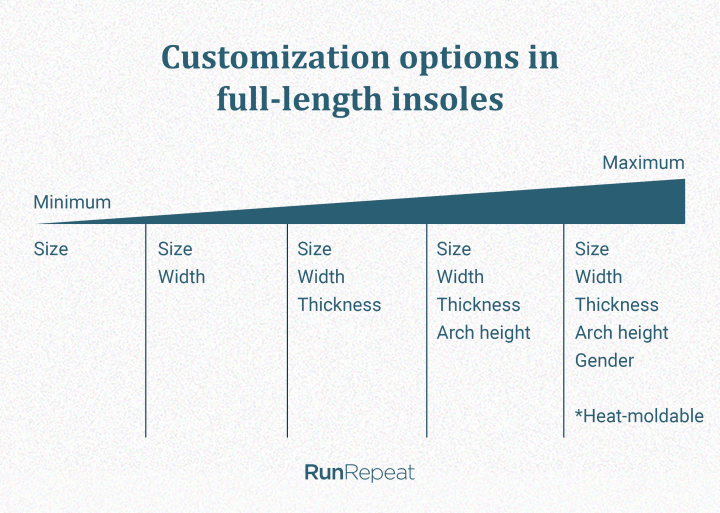
Size of the insoles
To ensure the proper fit, you should always look for your size. However, brands tend to do these in bulk. So the more sizes the brands offer, the better! You’ll have to trim less of the insole material and have better chances at ensuring a really good fit.
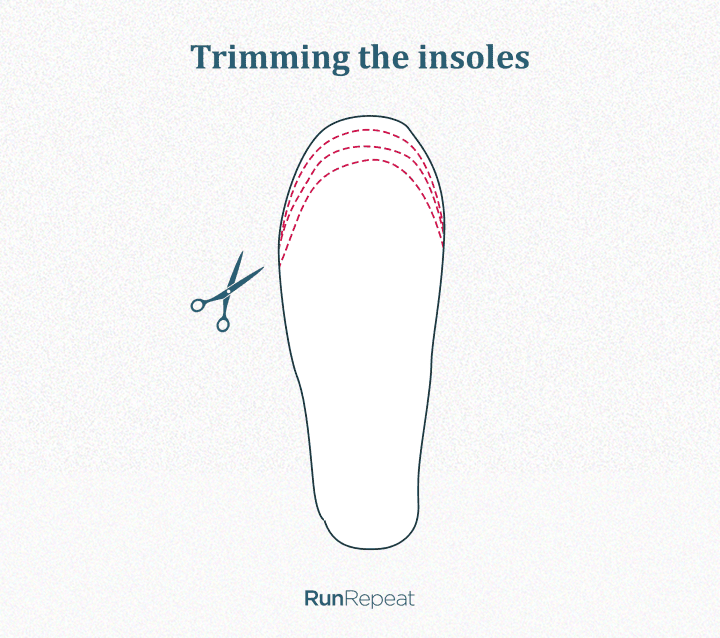
Width of the insoles
Just like when buying shoes, you should look for the width you need. Many brands today offer insoles for feet that are 3E to 6E wide.
Thickness of the insoles
Usually, 2 types of inserts can be found: thin and not thin (regular, inserts without “width description”).
There’s no such thing as an industry standard for the thickness of the insoles. These numbers vary a lot, but finding “thin” and “regular” options does the job. The thickness of thin insoles can go as low as 0.08 inches or 2mm. Obviously, they can’t offer much support. On the other hand, there are insoles that are 0.4 inches or 1cm thick. Think layers! These ultra-thick insoles are used in high-volume shoes.
Before deciding on the thickness, you should know which shoes you’re buying the inserts for.
- Are they low-volume race shoes or dress shoes? Low in profile, tight, snug? Then look for thin insoles.
- Are they regular running shoes, daily trainers or walking shoes? No need to go for the thin option. Great!
Arch height options for insoles
This applies to supportive insoles.
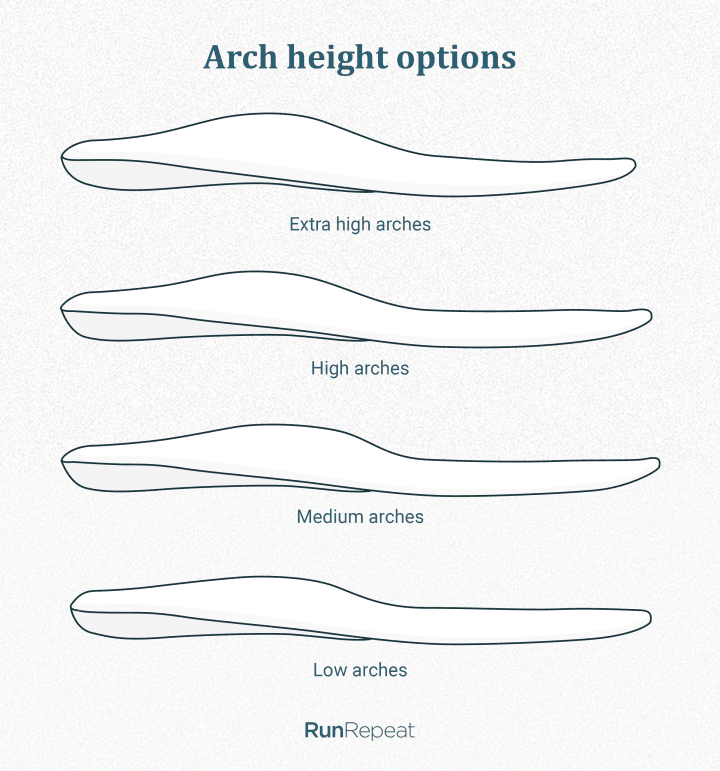
We covered arch height extensively in our Arch Support for Runners guide. It’s important to know that not all arches are the same, going from flat to really high.
On the bright side, we’re not talking about measuring this in millimeters. The goal is for the insole (and its dome in the midfoot area) to provide full contact with your foot. Brands usually list their (3 or 4) arch height options on their website so you can decide what’s the best option for you.
Gender differences in insoles
It’s that simple: insoles can be gender-differentiated. And should be. It’s best to look away from unisex models when possible and find insoles for men or insoles for women.
Heat-moldable insoles
The chart above applies to both cushioned and supportive insoles. Omit arch height if looking at cushioned insoles only without any arch support.
That one option that’s a bit out of place is saved for heat-moldable insoles. These insoles are made of heat-moldable plastic. They are best used for extra cushioning only and neutral pronation.
Since they mold around your feet, they are considered semi-customized insoles. However, there are many flaws in this concept:
- You should put them in the oven so they soften, then stand on them so they can conform to your feet’s contours. Given that they soften up, chances are small they will provide the firm structure your feet might need.
- They incorporate the issue you may be trying to address into the structure of the insole. How can they help resolve the issue then? For example, if you overpronate and use heat-moldable insoles, they will not prevent your foot from excessive rolling inwards. They will keep the shape as is. No additional support.
- Their softening ability also raises the question of durability.
What are insoles and orthotics good for?
These are the most common things that your insoles and orthotics might help you with. Given that orthotics are worn long-term and are fully customized, they are more capable of actually treating foot conditions, while insoles usually offer temporary relief.
| Insoles (inserts, footbeds) | Orthotics |
|
|
If you’re interested in what science has to say about the efficiency of inserts and orthotics, read the next chapter.
How effective are insoles and orthotics?
To check the claims mentioned in the previous chapter, we’ve looked at the scientific studies. Overall, the situation is not ideal because most of them have a small target group. We did not include specific conditions here (like plantar fasciitis, flat feet, etc. they are covered in depth later on).
This is what we’ve found out:
| Effects of insoles and orthotics found in studies published in the past X years | ||
| Insoles/inserts | ||
| Focus | Impact | Conclusion |
| Impact forces in running |  |
The use of cushioned insoles led to significant reductions in impact forces (mean vertical ground reaction force peak impact, ground reaction force loading rate and peak tibial accelerations) during running in healthy subjects (source). Insoles were cushioned. |
| Stride length and stride rate, flight and contact time |  |
With insoles: lower stride length, flight and contact time. Higher stride rate. Insoles were textured and had arch support. Read this study for more information. |
| Excessive pronation and foot varus alignment | ~ | Insoles are able to modify motion related to lower limb injuries with increased foot pronation and foot varus alignment. There were some non-desired effects on the knee motion (source). Insoles had arch support and 7˚ medial wedges (thicker on the inner side of the feet). |
| Prefabricated vs. heat-molded insoles |  |
Custom-made (heat-molded) insoles led to lower shock acceleration rates than the prefabricated insoles and showed better shock attenuation behaviour. For more details, read this study. |
| Knee pain |  |
+Medially posted insoles reduced eversion variables, but had a small influence on the transverse plane k+inematics of the tibia or knee. This means they might have an effect on knee pain, but by influencing oth+er variables, not directly. Read more here. |
| Running injuries |  |
Insoles (Dr. Scholl’s) reduced peak vertical loading rates by 16% which are associated with plantar fasciitis. Results for tibial stress syndrome (shin splints) and patellofemoral pain syndrome (kneecap pain) were inconsistent. |
| Kneecap pain |  |
Semi-customized insoles might reduce patellofemoral pain symptoms in recreation runners. This was shown after a period of 4 weeks. Details here. |
| Hemolysis and long distance running |  |
Firm insoles (unlike soft insoles) effectively reduce hemolysis in runners during long distance running. Read the study in full. |
| Plantar loading and long distance running |  |
The use of insoles might serve as a protective mechanism for plantar overloading in long distance running (source). |
| Rare foot alignment |  |
Arch support heights might not exert a crucial influence on rear foot alignment during gait. Foot orthoses used were noncustomized and had medial arch support of various heights (source). |
| Foot pain |  |
Insoles reduce foot pain in women during daily activities, as shown here. |
| Running economy |  |
Shock-absorbing insoles were associated with negative effects on the running economy as per this metastudy. |
| Low back pain and walking |  |
This study demonstrates that the low back pain decreased significantly after the use of real insoles compared to placebo ones. |
| Orthotics | ||
| Comfort: prefabricated insoles vs custom orthotics |  |
This study shows that prefabricated insoles constitute a reasonable alternative to custom-made insoles in terms of comfort. |
| Running economy |  |
Foot orthoses were associated with small negative effects on the running economy (compared to no orthoses), as shown in this metastudy. |
Materials used in insoles and orthotics
When looking at the insole, you might notice the sole material and the overlay material. Some insoles have overlays because the main compound isn’t breathable enough or grippy enough.
The majority of inserts are treated with antimicrobial or anti-odor technologies (for example, they can have silver ion technology embedded in the top layer).
These are some of the combinations found in insoles. There are many combinations because there are many materials and many purposes (different anatomies).

On the bottom, you may find adhesive elements which help inserts stay in place. This is especially important for partial shoe inserts.
| Materials used in insoles and orthotics and their purpose | |
| Materials | What they are good for |
| Foam | Incredibly soft. Used for cushioning mostly. Great choice for inserts made for standing all day and pressure relief. Less support than found plastic and carbon fiber inserts. |
| Gel | Gel offers the best shock absorption. Gel inserts are used for cushioning. Their weight is their flaw. But they are found in inserts for shin splints, foot fatigue and are great for high-impact activities (sports). |
| Plastic | Really stiff and usually found in rigid insoles. Has no “give” and offers maximal support. Strong and lightweight. |
| Carbon fiber | Really stiff and usually found in rigid insoles. Has no “give” and offers maximal support. Thinner and even lighter than the plastic insoles. |
| Cork | Support (and some cushioning). Usually found in semi-rigid insoles. Softer than carbon fiber and plastic, but definitely not squishy. |
| Leather | Cushion only and it feels good. |
| Wool | Best insulation, both in warm and cold weather. Usually found as an overlay due to its properties. |
| Bamboo fibers | For wicking moisture. Found in overlays. |
| Wicking synthetic materials | This top layer can also be perforated or dimpled. Placed there for its moisture-wicking features. |
Insoles for plantar fasciitis and heel pain
The most common full-length inserts for plantar fasciitis and heel pain found on the market offer both cushioning and arch support. They also come with a deep heel cup.
Given that heel pain and plantar fasciitis are so common in walkers and runners, we’ve found many studies to help you understand what insoles and orthotics can and can not help with. Dig in!
| Studies on plantar fasciitis and heel pain | |
| Type of insoles | Results |
| Customized (Sorbothane and Plastazote, had a cork-reinforced medial arch) heel pads and soft orthotics. | They led to a significant reduction in pain after 5 weeks in patients with heel pain associated with plantar fasciitis. Read more in this study. |
| Magnetic insoles | Magnets embedded in cushioned insoles do not provide additional benefit for subjective plantar heel pain reduction when compared with nonmagnetic insoles (read more here). |
| Full-length silicone insoles | They are recommended as the first line of treatment for persons with plantar fasciitis. |
| Prefabricated and custom orthotics | They reduce pain and improve function in adults with acute plantar fasciitis with few risks or side effects. Orthotics are effective and well tolerated by patients for short-term pain relief and improved function. Prefabricated orthotics are less costly and provide similar relief to more expensive custom orthotics (source). |
| EVA insoles | Insoles can be used to reduce pain while walking and to increase the walking distance in people with plantar fasciitis, as explained here. |
| Prefabricated semi-rigid insoles | For most patients with plantar heel pain, prefabricated semi-rigid insoles such as the Powerstep™ devices used in the present trial provide short-term benefit equivalent to that of bespoke, casted foot orthoses, but at considerably reduced costs. |
| Contoured full-length insoles vs. heel cups | This metastudy has shown that contoured full-length insoles are more effective in relieving plantar fasciitis symptoms than heel cups. |
| Custom orthotics | This study has shown that custom foot orthoses in new shoes improve first-step pain and reduce plantar fascia thickness over a period of 12 weeks. |
| Plantar orthoses | In this study, during 9 weeks, patients with plantar fasciitis wore plantar orthoses and have experienced a reduction in pain. But, that’s all that happened - no neural changes occurred (plantar fasciitis was not cured). |
Insoles for flat feet
Flexible flatfoot is not the same as rigid flatfoot (if you’re unfamiliar with these terms, find explanations in our in-depth guide on arch support).
The most common insoles for flat feet on the market come with really noticeable arch support. Along with that, they have a deep heel cup and can even be ⅔ length inserts.
This is an overview of what studies have shown regarding the effectiveness of inserts for flat feet.
| Studies on inserts and flat feet | |
| Type of insoles | Results |
| Orthotic insoles | It’s necessary to wear orthotic insoles for flexible flatfoot to prevent further deformation, as this study has shown. |
| EVA orthotic insoles | Orthotic insoles could significantly improve the plantar pressure of flatfoot as shown here. The thickness of the foot arch was 2.6 cm, and the thickness of the forefoot and heel was 0.4 cm. |
| Over-the-counter insoles | Contrary to that, this study showed that over-the-counter insoles have no beneficial effects on the entire lower extremity in adults with flexible flatfoot. |
| Arch support insoles | In uphill and downhill walking, wearing arch support insoles can be beneficial because it decreased oxygen uptake and there was less muscle fatigue during downhill walking (source). |
| Textured insoles with different arch heights | This study has shown that the use of textured insoles designed with different arch heights could not effectively improve the plantar pressure distribution and body stability in people with flat feet. However, they did improve body stability and plantar collapse. |
| Customized orthotics | 1 year of wearing customized insoles (orthotics) helped reduce body weight and bmi, made positive improvements in vertical jumps, Cooper test and 30m sprints. Insoles used were individually designed based on height, length and function of the sole of each participant with flat feet. Read about this here. |
| Hard orthopedic insoles with arch support | Harder insole materials result in higher plantar pressure. But, by wearing the orthopedic insole made up with the material of 40° hardness and arch height of 33mm, the arch height was elevated up to twice of the initial barefoot weight-bearing condition (source). |
Insoles for high arches
Custom insoles decrease plantar foot pressure in people with high arches and improve the efficient use of muscles. The support from custom-made insoles can help patients to walk because they relieve the burden and fatigue in the lower limbs (study).
In a study of 154 participants with painful high arches it was found that, with custom foot orthoses, and after 3 months, foot pain decreased, function was better, plantar pressure was improved.
Insoles for overpronation
Given that you want to prevent the excessive rolling inwards of your feet, you should look for semi-rigid or rigid arch support insoles. They also offer support in the heel area which helps stabilize your feet. Keep in mind that rigid arch support inserts need some adaptation period, so don’t rush it.
Best insoles for women
Best insoles for women are those actually made for women.
Women’s feet are not men’s feet size small. Female feet aren’t only shorter and narrower (on average), but more differences have been found in the arch, the lateral side of the foot, the first toe, and the ball of the foot (as explained in this study).
If you’re buying prescription orthotics, you’re getting the best customization possible. But, if you’re looking at over-the-counter insoles, how to judge their quality in terms of customization? Well, best if there’s a women option.
Anatomy-wise, women’s feet are different from men’s feet:
- Paying the pink tax would be the worst option possible.
- The next worst thing would be buying the men’s insoles colored in pink.
A lot of brands take pride in making gender-specific inserts. So if you’re looking for insoles for women, don’t settle for the unisex option (or a men’s version in pink).
Custom orthopedic insoles (orthotics)
As mentioned above, these need to be prescribed by a medical professional: a podiatrist, sports medicine physician or orthopedic surgeon. This means you will go through a thorough examination of your feet, legs, posture.
Since orthotics need to be prescribed, they are not the focus of this guide. It is important, however, to mention that you should always be aware of orthopedic inserts sold as “customized” while the only customization is leaving footprints in the foam you got from them via email and sending it back to them. This is not the proper way of making a 3d model of your feet.
The main challenge is: how not to create a model and insoles that will not build in your current issue. That’s why a visit to the specialist is a must.
Time needed to get used to the insoles
Cushioned insoles are usually good straight out of the box. That’s what they are for: more comfort. However, supportive insoles might take time to get used to.
You should start wearing them gradually. Start with 1 hour a day and increase that time as you get used to the inserts. If you go on a long walk or run the moment you buy them for the first time, they might feel uncomfortable or even lead to pain which is not the idea.
How to clean insoles
Never put them in a washing machine, to be on the safe side. However, some brands do specify how to wash them in the machine, if possible (usually using a delicate program). It’s usually possible for insoles with no rigid support. Otherwise, hand wash them using mild soap, lukewarm water and wash them by hand.
